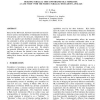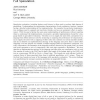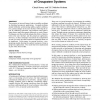673 search results - page 14 / 135 » A timing model for synchronous language implementations in s... |
WSC
1998
13 years 9 months ago
1998
Based on the DIS result, the HLA framework has been defined to achieve interoperability of independent simulators. Concurrently, and for the most part, independent of that effort,...
POPL
1996
ACM
13 years 11 months ago
1996
ACM
that defines abstract costs for measuring or analyzing the performance of computations, (2) to supply the users with a mapping of these costs onto runtimes on various machine model...
CSCW
2011
ACM
13 years 2 months ago
2011
ACM
The presence of network latency leads to usability problems in distributed groupware applications. Example problems include difficulty synchronizing tightly-coupled collaboration...
IPSN
2009
Springer
14 years 2 months ago
2009
Springer
Data Driven Time Synchronization (DDTS) provides synchronization across sensors by using underlying characteristics of data collected by an embedded sensing system. We apply the c...
ICC
2007
IEEE
14 years 2 months ago
2007
IEEE
Single-frequency simulcast networks use two or more Radio Base Stations (RBS) to transmit simultaneously the same signal on the same radio channel over the service area. To ens...



